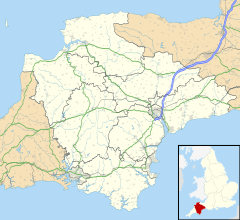Hope Cove facts for kids
Quick facts for kids Hope Cove |
|
|---|---|
 |
|
| OS grid reference | SX676402 |
| Civil parish | |
| District | |
| Shire county | |
| Region | |
| Country | England |
| Sovereign state | United Kingdom |
| Post town | KINGSBRIDGE |
| Postcode district | TQ7 |
| Dialling code | 01548 |
| Police | Devon and Cornwall |
| Fire | Devon and Somerset |
| Ambulance | South Western |
| EU Parliament | South West England |
| UK Parliament |
|
Hope Cove is a small, charming village by the sea. It's located in Devon, England, a beautiful county in the southwest. You can find it about 5 miles (8 km) west of Salcombe and 5 miles (8 km) southwest of Kingsbridge. The village has two lovely beaches, and a large piece of land called Bolt Tail helps keep them safe from strong winds.
A Look Back in Time
The name Hope Cove might come from an old language, Old Norse. The word hóp meant "bay" or "small inlet."
Historically, Hope Cove was split into two parts: Outer Hope to the north and Inner Hope to the south. Both parts of the village started out as places where people made a living from fishing. Hope Cove also became known for smuggling goods and for finding valuable items from ships that had crashed.
The Spanish Armada
In 1588, the famous ships of the Spanish Armada sailed past the village. After the Armada was defeated, a Spanish hospital ship called the San Pedro el Mayor was caught in a storm. It crashed onto the rocks between Inner and Outer Hope. About 140 people survived the shipwreck. They were eventually sent back to Spain.
Art and War
A famous Victorian painter, Sir Luke Fildes, visited Hope Cove. He found inspiration for his oil painting The Doctor from a cottage in the village.
During the early days of World War II, a special radar station was set up near Hope Cove. It was called 'RAF Hope Cove'. Later, an airfield named RAF Bolt Head also opened nearby. Many RAF personnel stayed in Hope Cove during the war. Both bases closed after 1945. However, RAF Hope Cove reopened in the 1950s. It was expanded with a large underground bunker. This was to help protect against threats during the Cold War. The site was finally sold off in 1999.
Hope Cove was also a filming location for the British comedy movie The Supergrass. This film was made in late 1984 and released in 1985. It starred popular comedians like Adrian Edmondson, Jennifer Saunders, and Dawn French.
Hope Cove Lifeboat
The Royal National Lifeboat Institution (RNLI) opened a lifeboat station in Hope Cove in 1878. They received four boats over the years, all named Alexandra. The station closed in 1930 because a nearby station at Salcombe had a new motor lifeboat. This new boat could cover the area around Hope Cove.
In 1992, a lifeboat service was started again. It was part of the Maritime and Coastguard Agency (MCA). However, the MCA stopped supporting the boat in 2010. After that, the Hope Cove Life Boat became an independent service. The village and visitors helped raise money to keep it going. A new boat, also named "Alexandra," was launched in 2013. The lifeboat is run by volunteers from the village. They train and respond to emergencies in their own time. You can find more details at www.hopecovelifeboat.org.
Hope Cove Today
Today, Hope Cove is mostly focused on tourism. The area is part of the South Devon Area of Outstanding Natural Beauty. This means it's a special place with beautiful landscapes.
In 2015, a new BBC TV drama called The Coroner started. It was filmed in Hope Cove, including a house right on the beach. The show had two series, with a total of 20 episodes.
The Cove Café Bar in the village was named the UK's Best Independent Craft Beer Bar (rural) in 2018.


